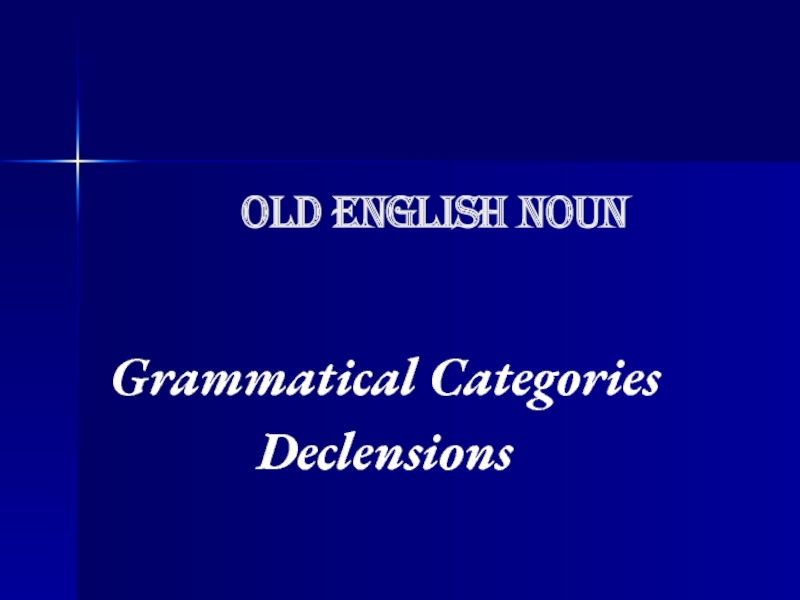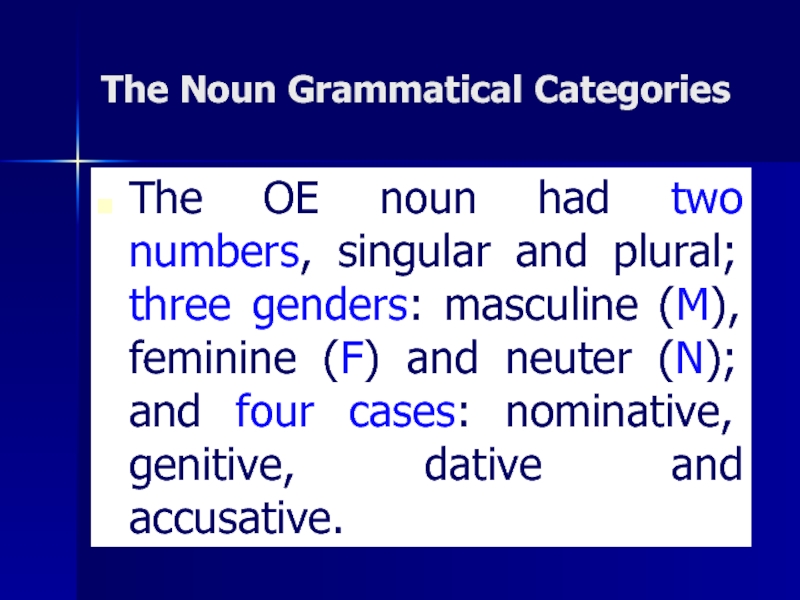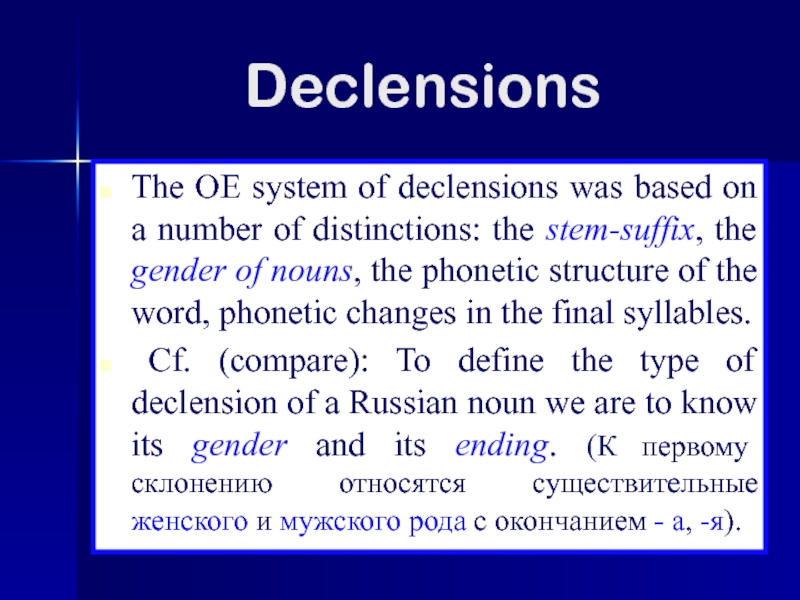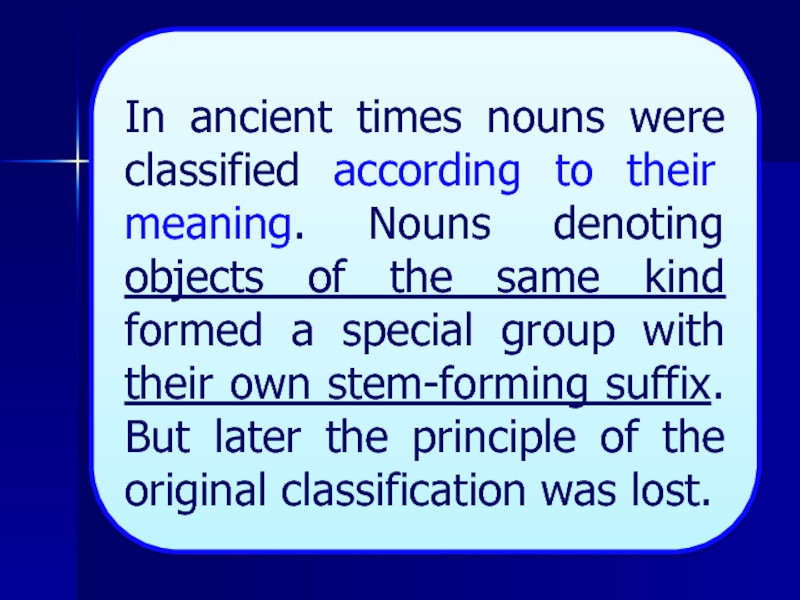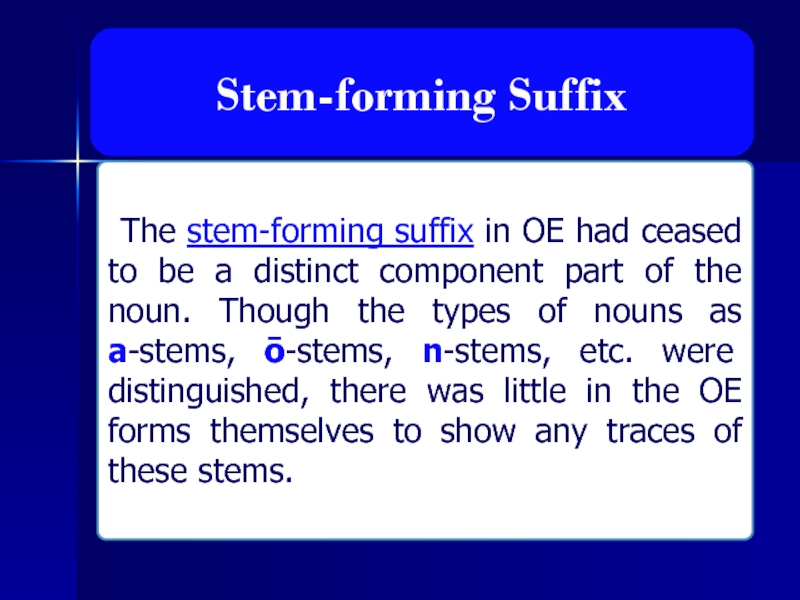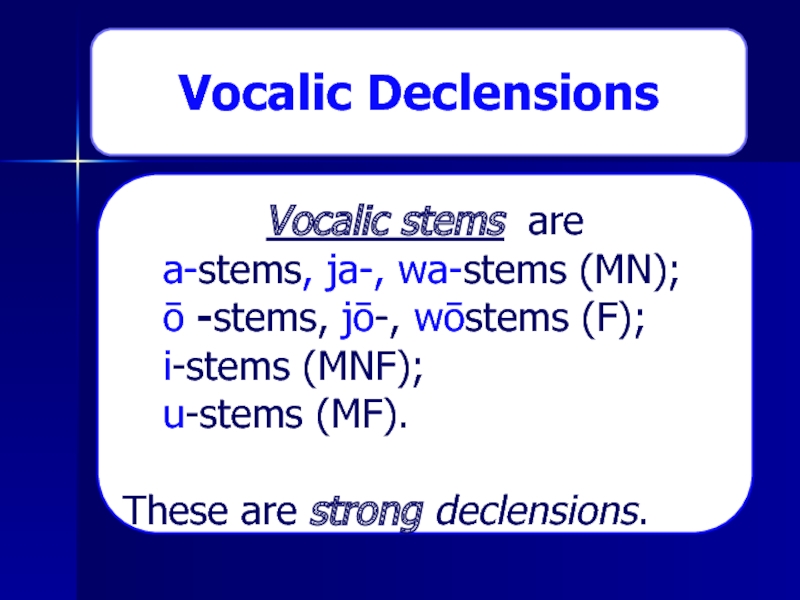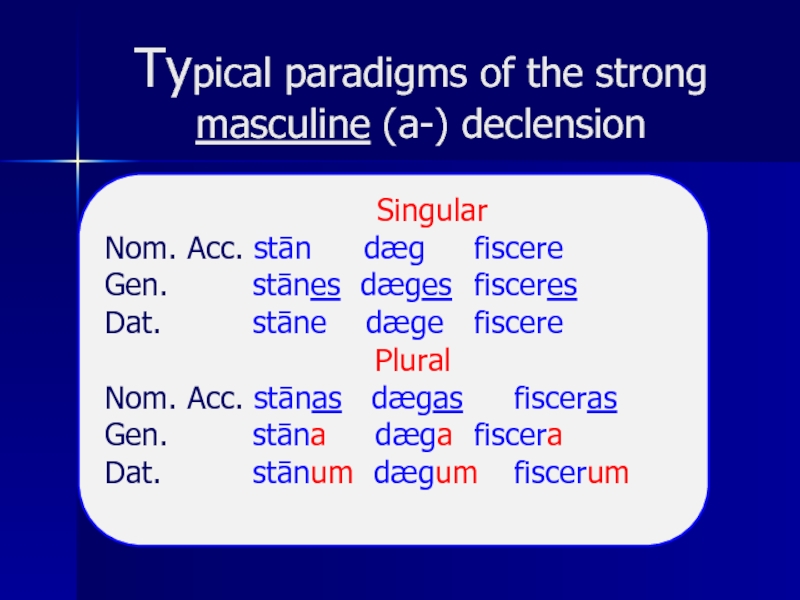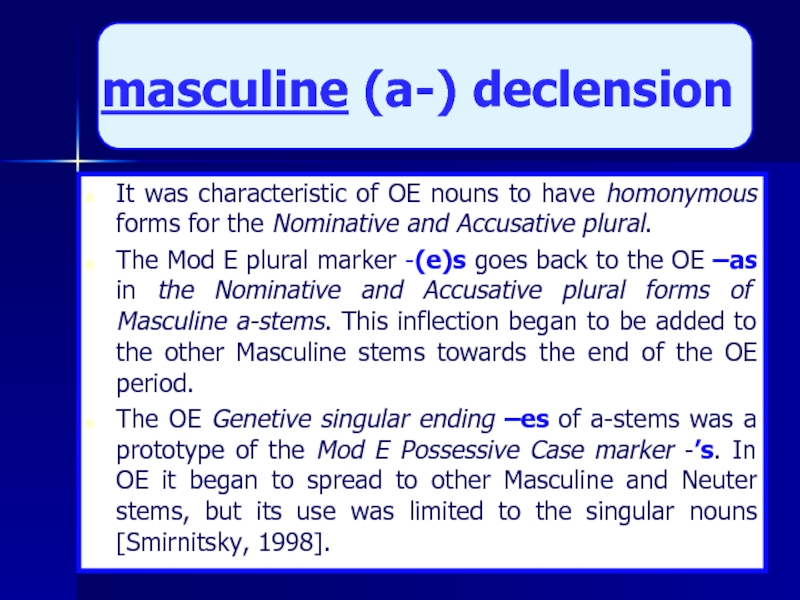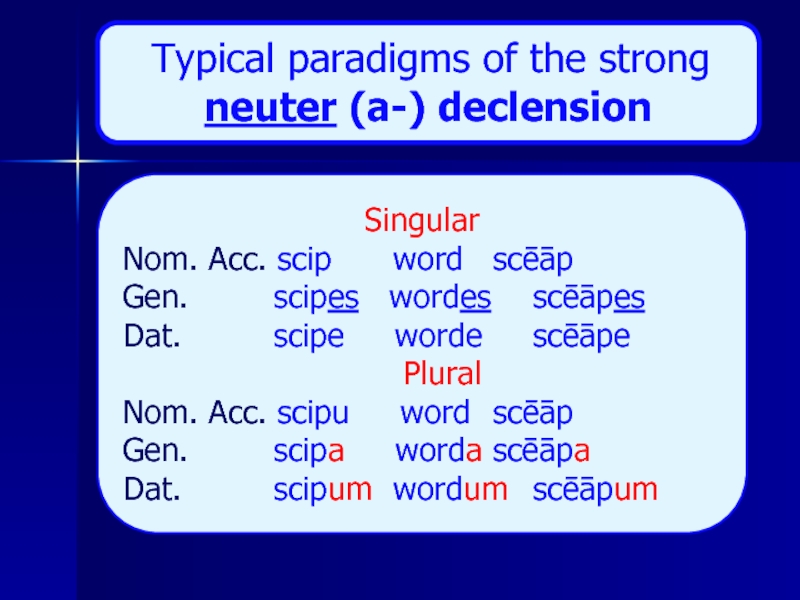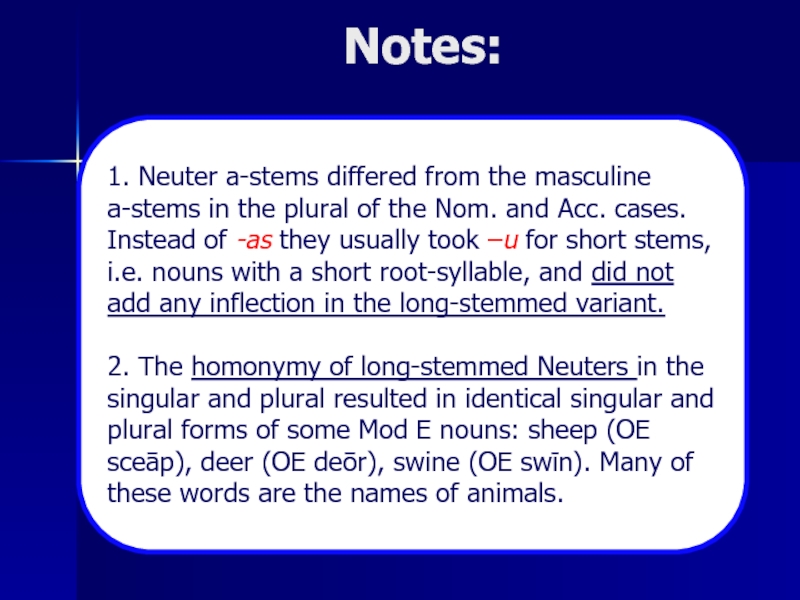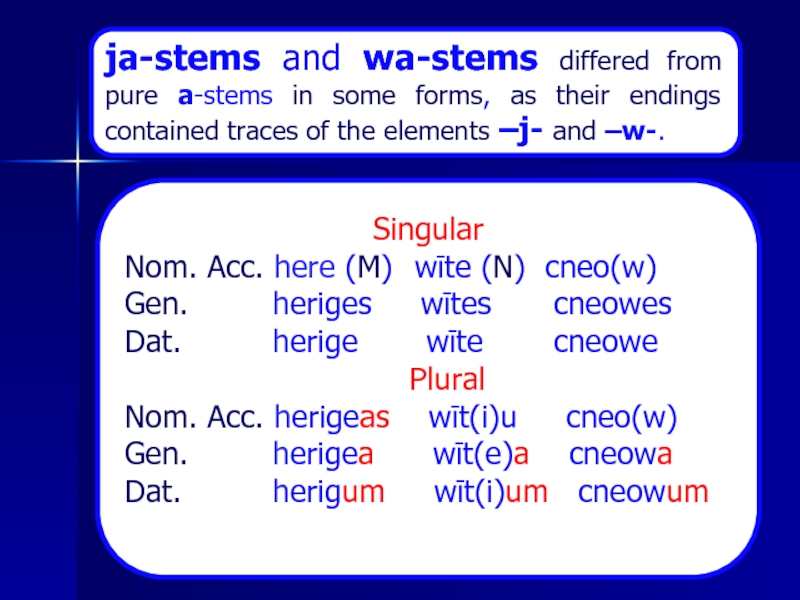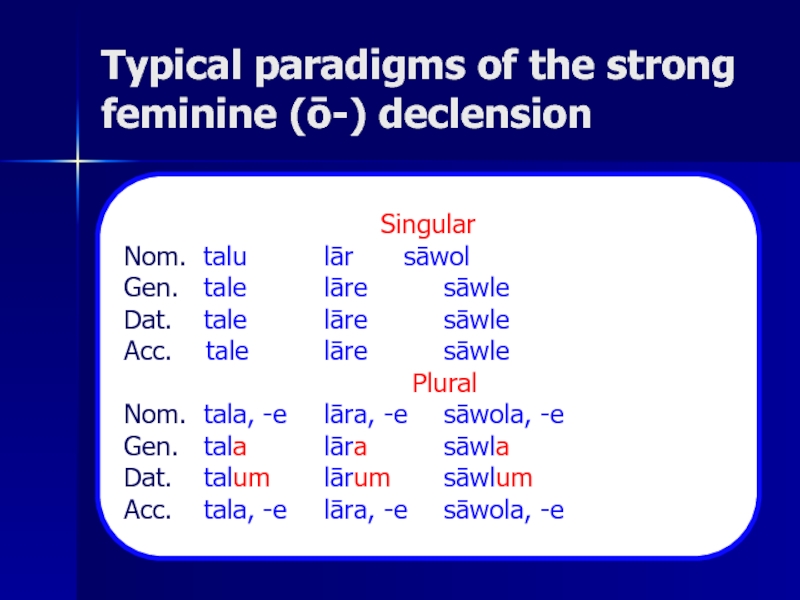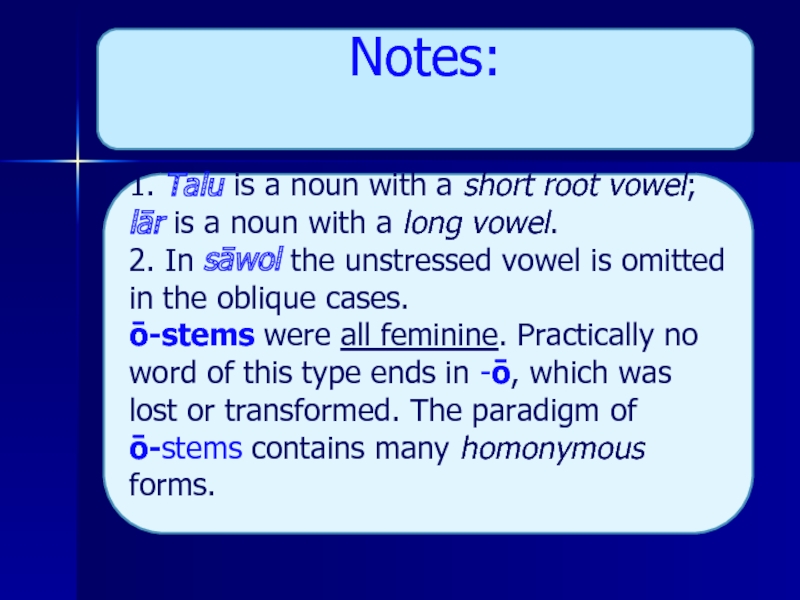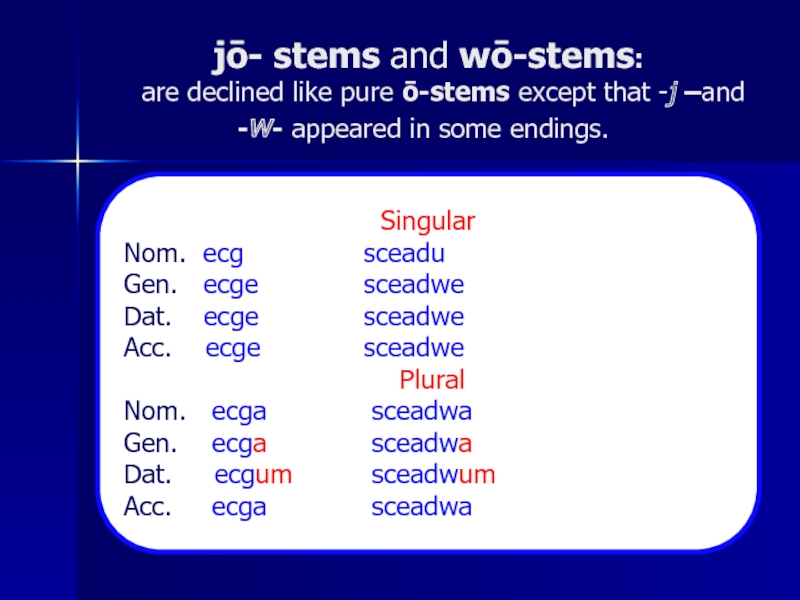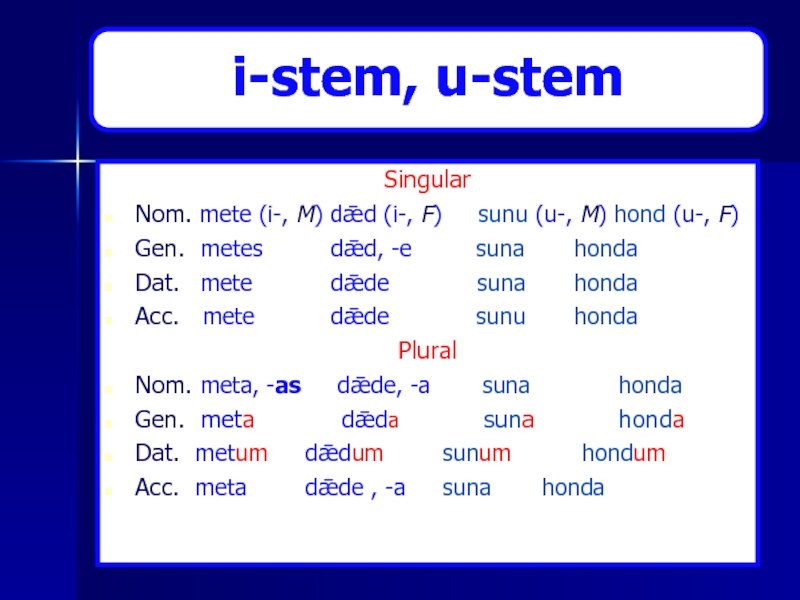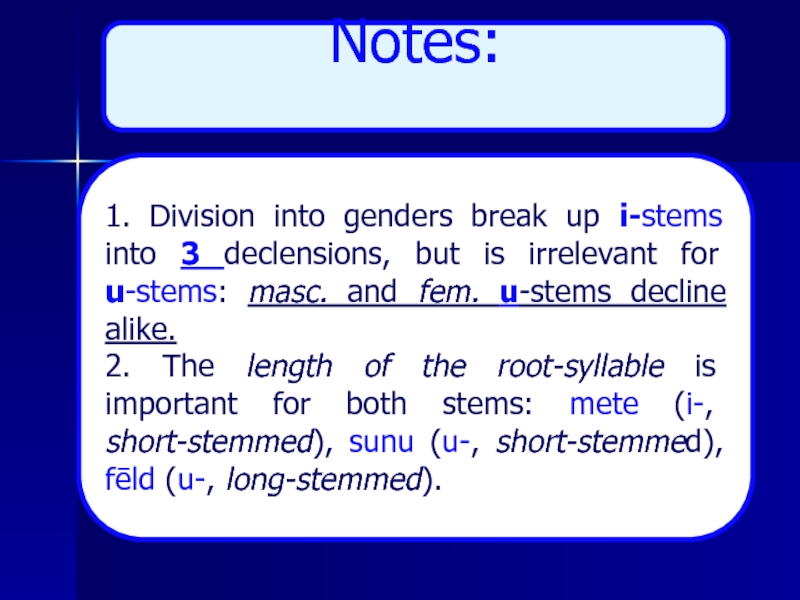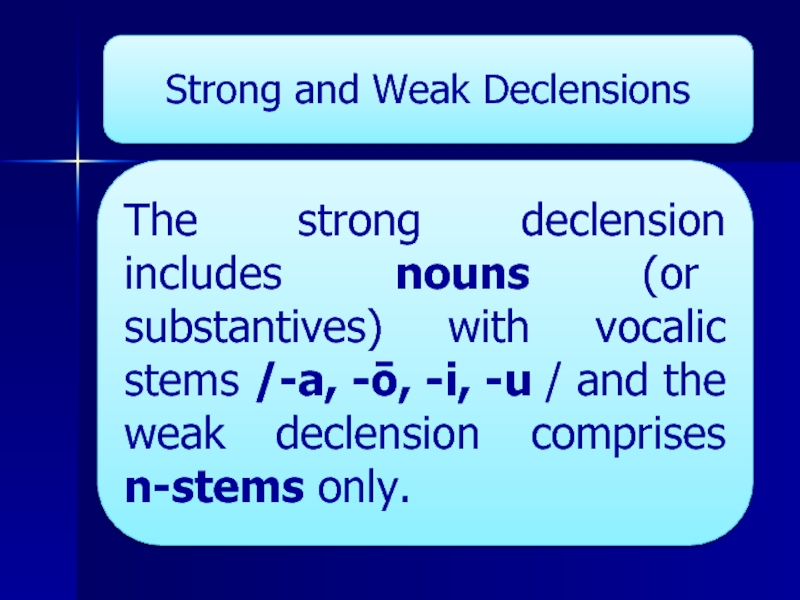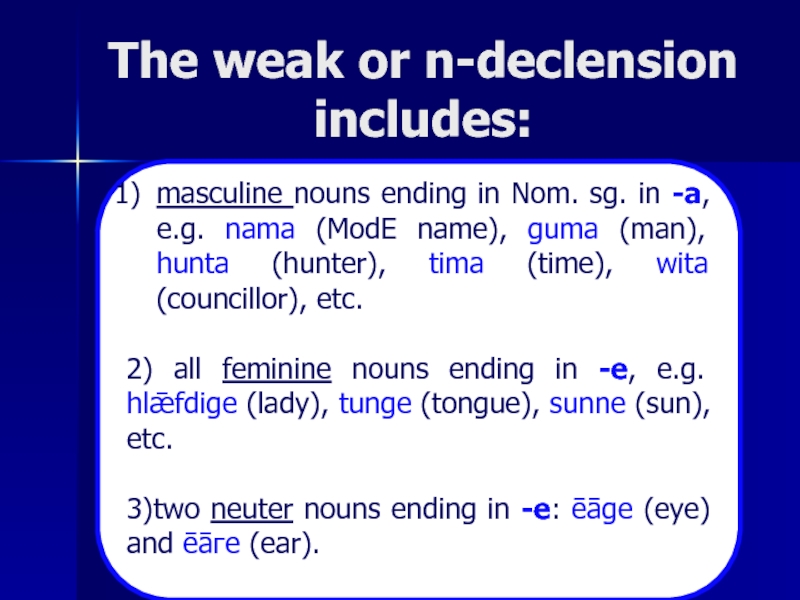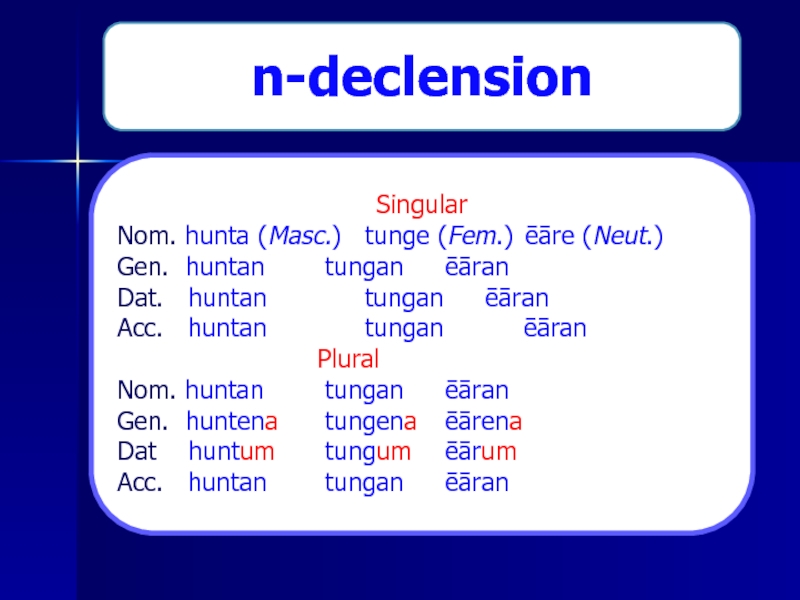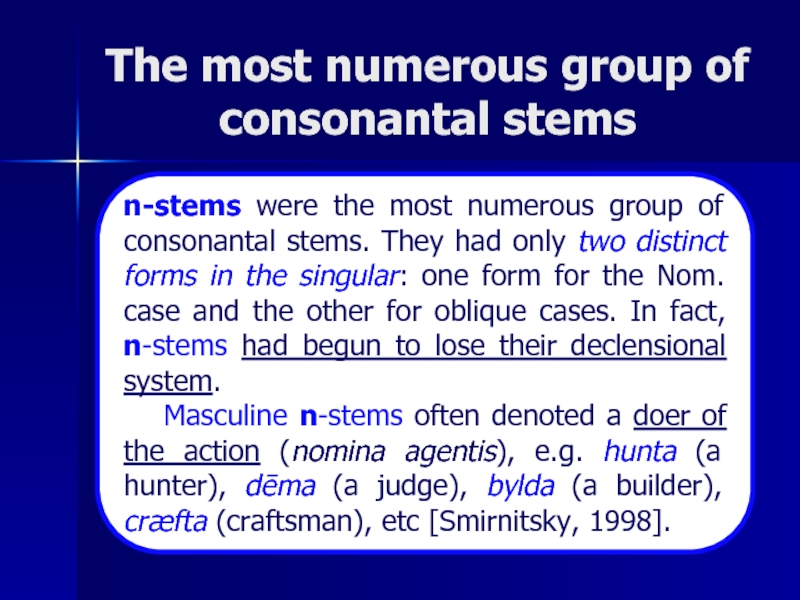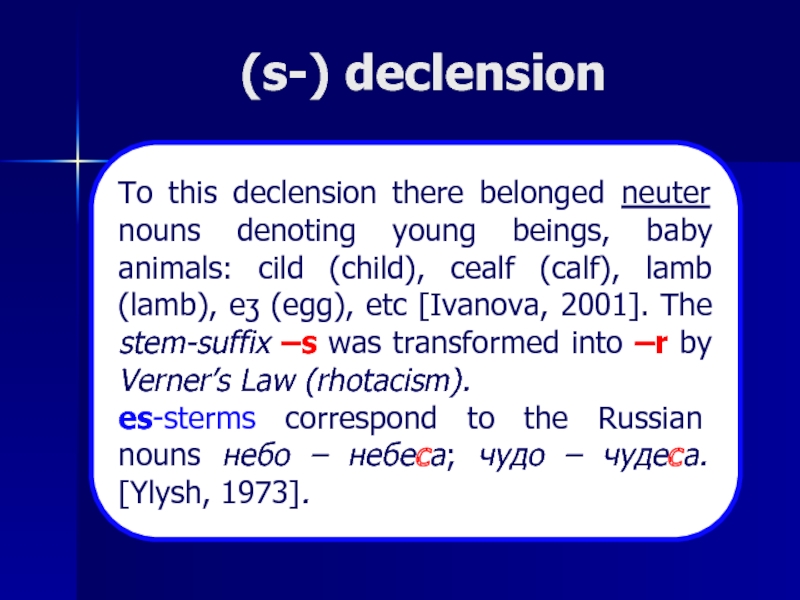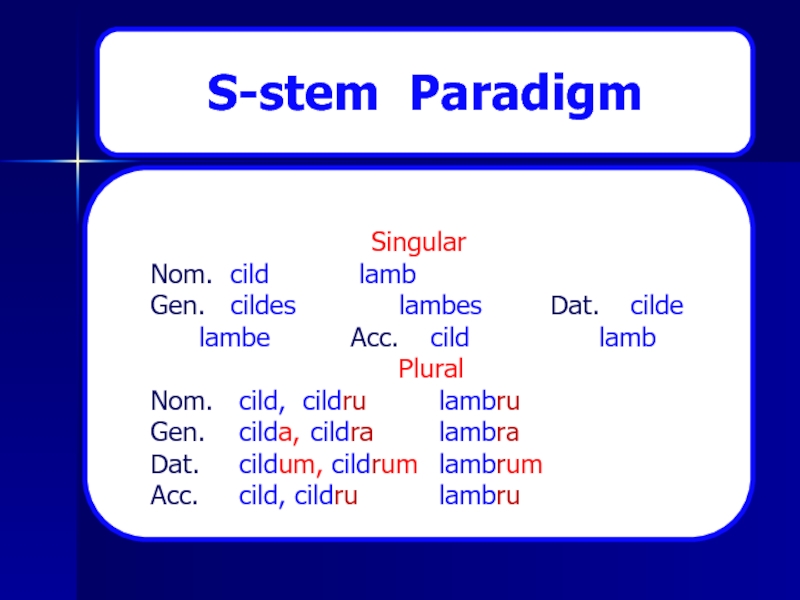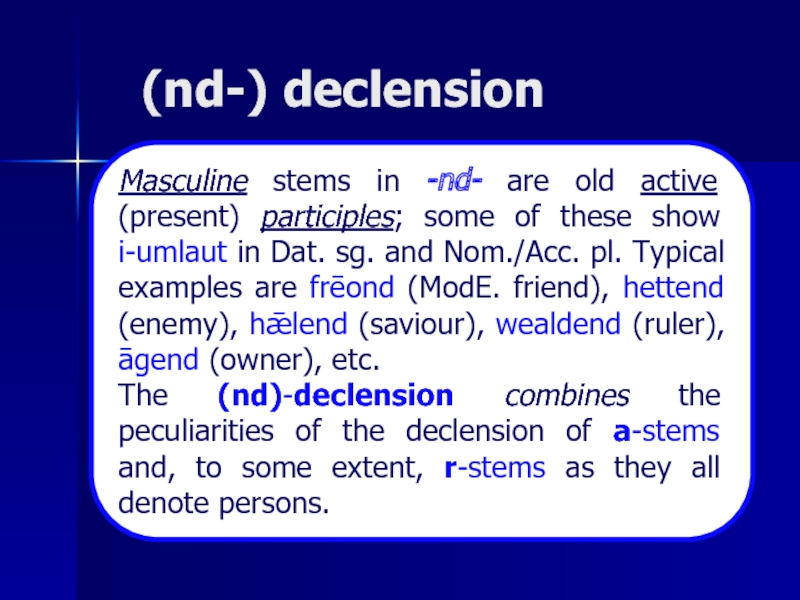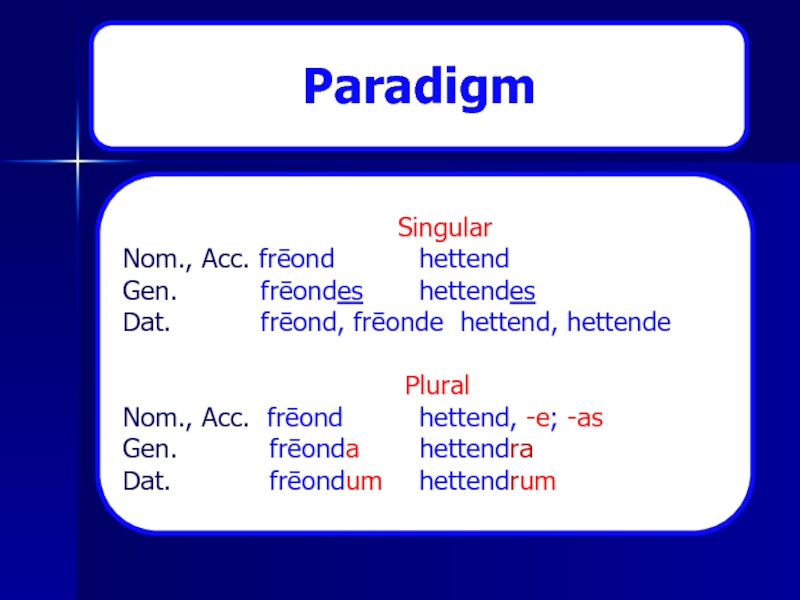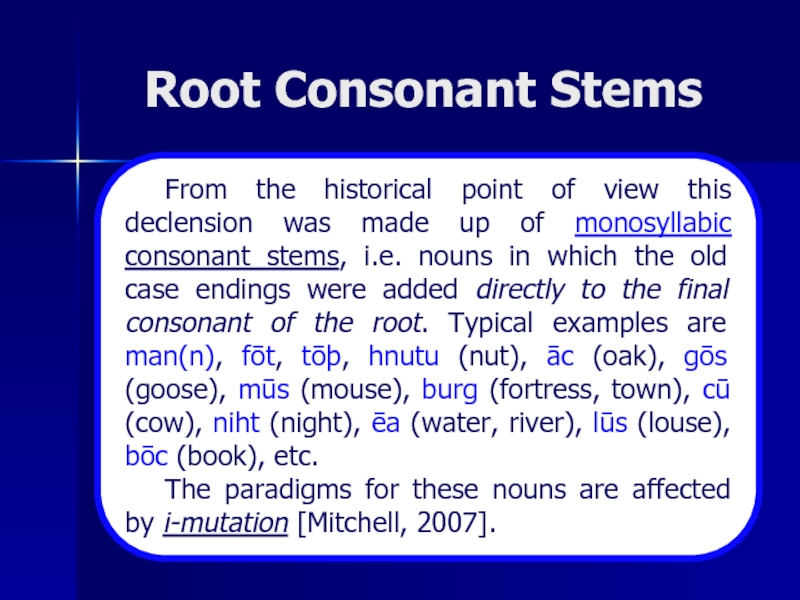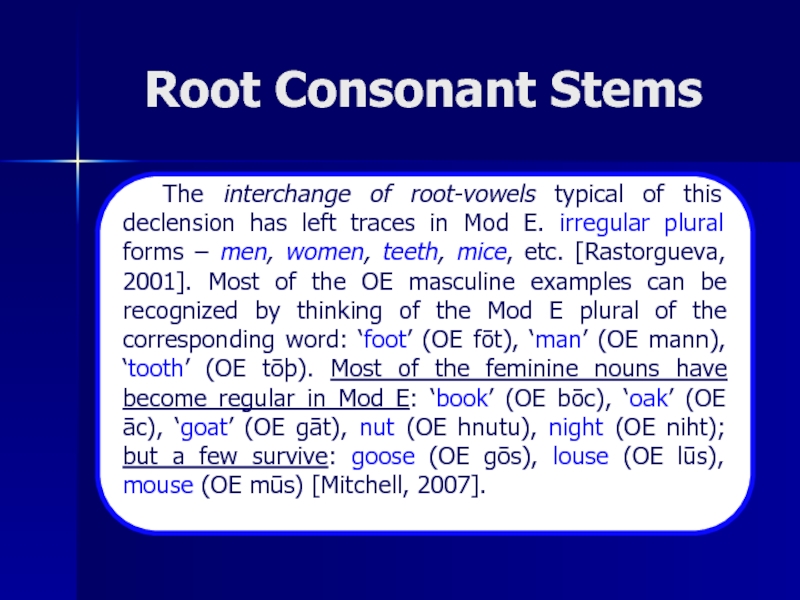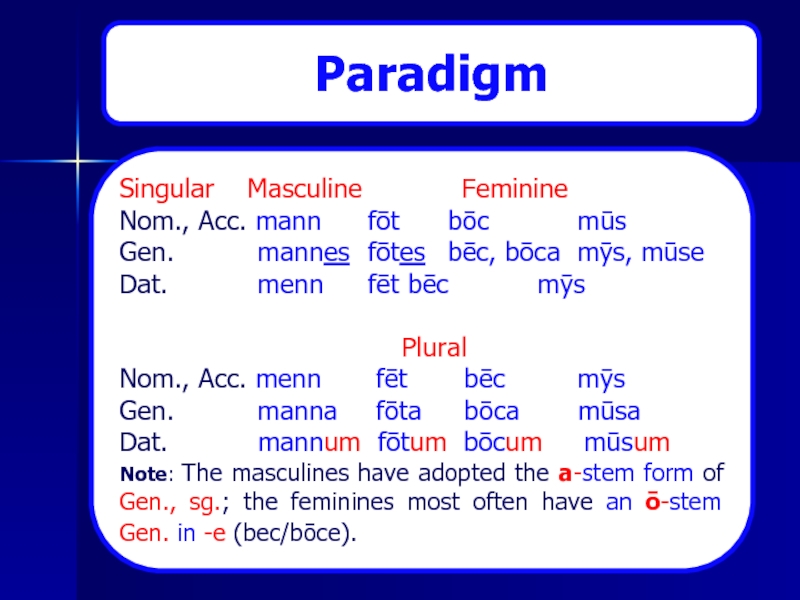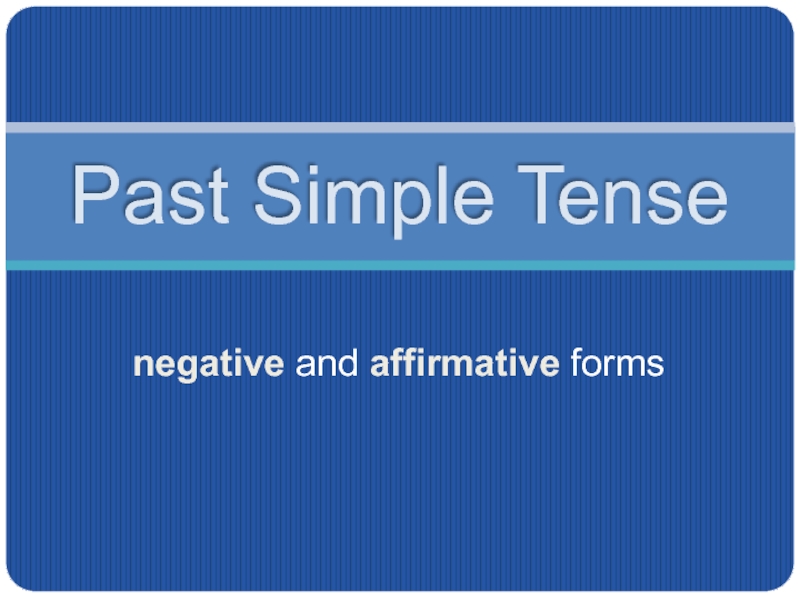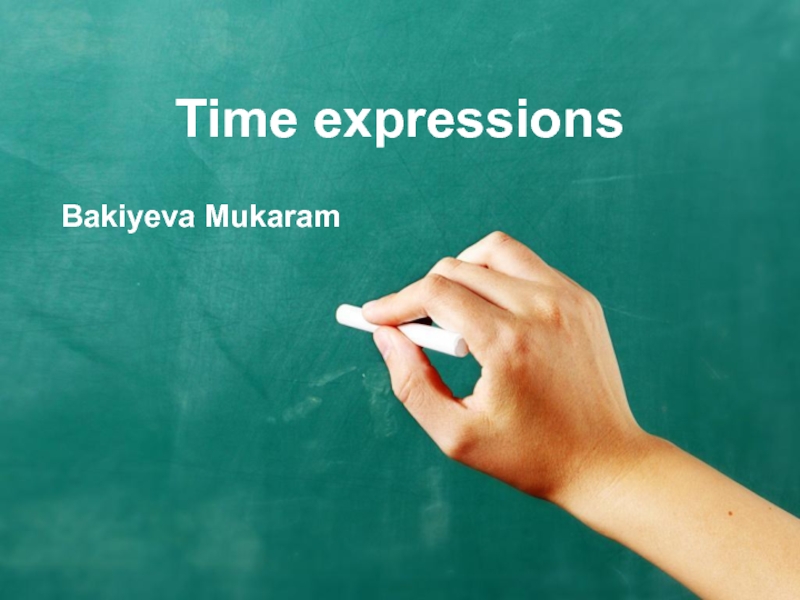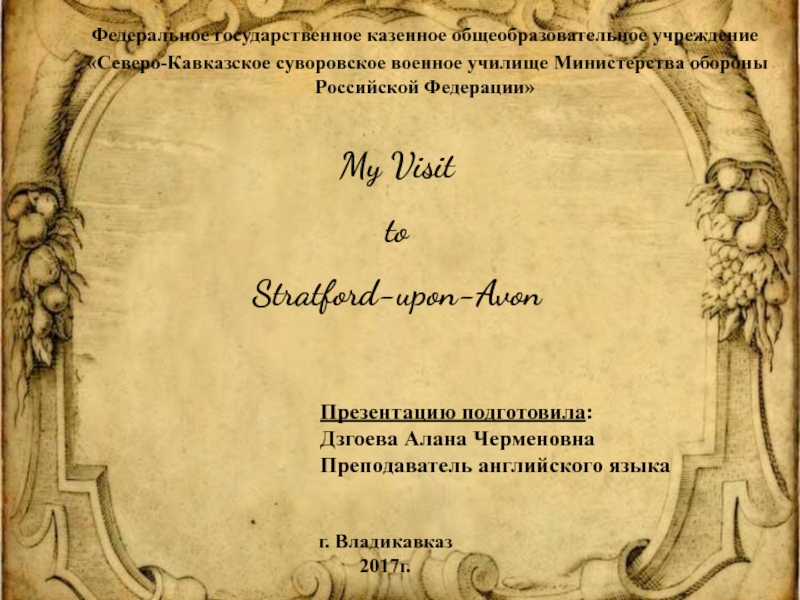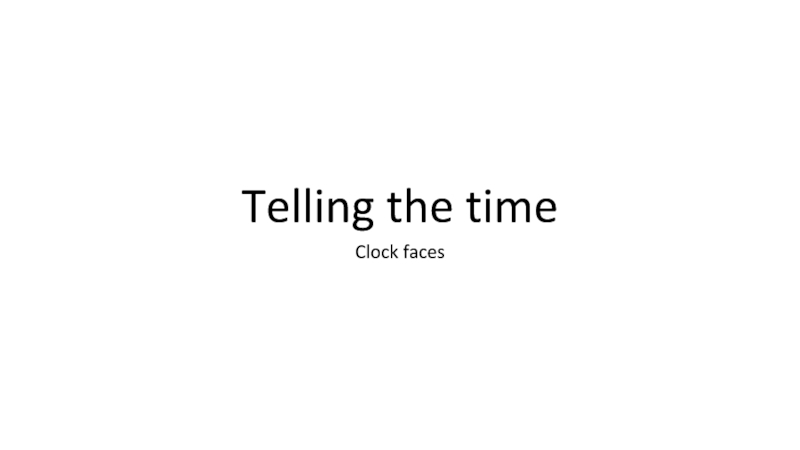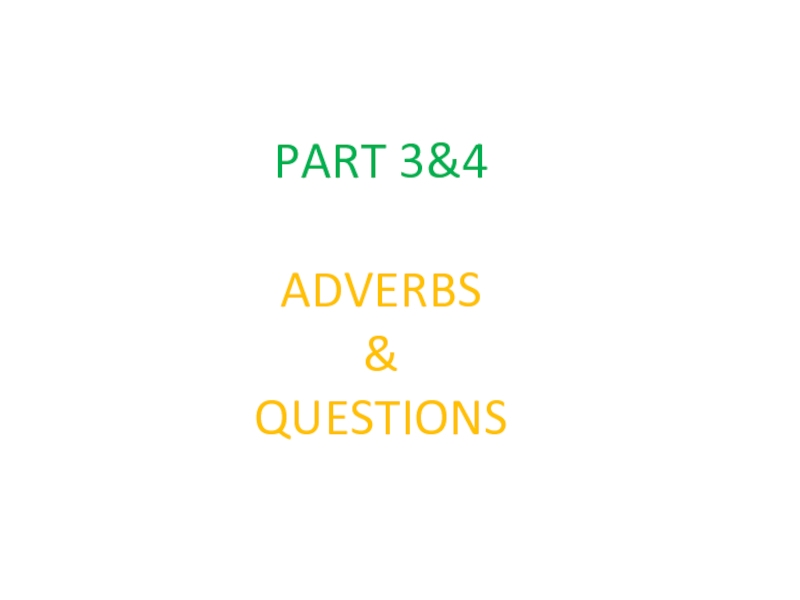- Главная
- Разное
- Дизайн
- Бизнес и предпринимательство
- Аналитика
- Образование
- Развлечения
- Красота и здоровье
- Финансы
- Государство
- Путешествия
- Спорт
- Недвижимость
- Армия
- Графика
- Культурология
- Еда и кулинария
- Лингвистика
- Английский язык
- Астрономия
- Алгебра
- Биология
- География
- Детские презентации
- Информатика
- История
- Литература
- Маркетинг
- Математика
- Медицина
- Менеджмент
- Музыка
- МХК
- Немецкий язык
- ОБЖ
- Обществознание
- Окружающий мир
- Педагогика
- Русский язык
- Технология
- Физика
- Философия
- Химия
- Шаблоны, картинки для презентаций
- Экология
- Экономика
- Юриспруденция
Old English Noun. Grammatical Categories Declensions. The Noun Grammatical Categories презентация
Содержание
- 1. Old English Noun. Grammatical Categories Declensions. The Noun Grammatical Categories
- 2. The Noun Grammatical Categories The OE noun
- 3. Declensions The OE system of declensions was
- 4. In ancient times nouns
- 5. , The stem-forming suffix in
- 6. Traces of stem-forming suffixes in
- 7. Vocalic Declensions Vocalic
- 8. Typical paradigms of the strong masculine (a-)
- 9. Productive declension About one third
- 10. masculine (a-) declension It was
- 11. Typical paradigms of the
- 12. Notes: 1. Neuter a-stems
- 13. . ja-stems and wa-stems differed
- 14. Typical paradigms of the strong feminine (ō-)
- 15. Notes: 1. Talu is
- 16. jō- stems and wō-stems: are declined
- 17. Singular Nom. mete (i-, M) dǣd
- 18. Notes: 1. Division
- 19. The strong declension includes nouns
- 20. The weak or n-declension includes: masculine
- 21. n-declension Singular Nom.
- 22. The most numerous group of consonantal stems
- 23. The only relics of n-stems in Mod
- 24. (r-) declension -r –
- 25. R-stem Paradigm Singular Nom. bгōþоr
- 26. (s-) declension To
- 27. S-stem Paradigm Singular
- 28. (nd-) declension Masculine
- 29. Paradigm Singular Nom.,
- 30. Root Consonant Stems From the
- 31. Root Consonant Stems The interchange
- 32. Paradigm Singular
Слайд 2The Noun Grammatical Categories
The OE noun had two numbers, singular and
Слайд 3Declensions
The OE system of declensions was based on a number of
Cf. (compare): To define the type of declension of a Russian noun we are to know its gender and its ending. (К первому склонению относятся существительные женского и мужского рода с окончанием - а, -я).
Слайд 4
In ancient times nouns were classified according to their meaning. Nouns
Слайд 5
, The stem-forming suffix in OE had ceased to be a
Stem-forming Suffix
Слайд 6
Traces of stem-forming suffixes in OE
The stem-forming suffix had merged
Слайд 7
Vocalic Declensions
Vocalic stems are
a-stems, ja-, wa-stems (MN);
ō -stems, jō-,
i-stems (MNF);
u-stems (MF).
These are strong declensions.
.
Слайд 8Typical paradigms of the strong masculine (a-) declension
Nom. Acc. stān dæg fiscere
Gen. stānes dæges fisceres
Dat. stāne dæge fiscere
Plural
Nom. Acc. stānas dægas fisceras
Gen. stāna dæga fiscera
Dat. stānum dægum fiscerum
Слайд 9
Productive declension
About one third of OE nouns were Masculine a-stem. More
The inflections of the Dative plural –um and Genitive plural –a were alike in all declensions.
Слайд 10
masculine (a-) declension
It was characteristic of OE nouns to have homonymous
The Mod E plural marker -(e)s goes back to the OE –as in the Nominative and Accusative plural forms of Masculine a-stems. This inflection began to be added to the other Masculine stems towards the end of the OE period.
The OE Genetive singular ending –es of a-stems was a prototype of the Mod E Possessive Case marker -’s. In OE it began to spread to other Masculine and Neuter stems, but its use was limited to the singular nouns [Smirnitsky, 1998].
Слайд 11
Typical paradigms of the strong neuter (a-) declension
Singular
Nom. Acc. scip
Gen. scipes wordes scēāpes
Dat. scipe worde scēāpe
Plural
Nom. Acc. scipu word scēāp
Gen. scipa worda scēāpa
Dat. scipum wordum scēāpum
Слайд 12Notes:
1. Neuter a-stems differed from the masculine a-stems in the plural
2. The homonymy of long-stemmed Neuters in the singular and plural resulted in identical singular and plural forms of some Mod E nouns: sheep (OE sceāp), deer (OE deōr), swine (OE swīn). Many of these words are the names of animals.
Слайд 13.
ja-stems and wa-stems differed from pure a-stems in some forms,
Singular
Nom. Acc. here (M) (wīte (N) cneo(w)
Gen. heriges wītes cneowes
Dat. herige wīte cneowe
Plural
Nom. Acc. herigeas wīt(i)u cneo(w)
Gen. herigea wīt(e)a cneowa
Dat. herigum wīt(i)um cneowum
Слайд 14Typical paradigms of the strong feminine (ō-) declension
Singular
Nom. talu lār sāwol
Gen. tale lāre sāwle
Dat. tale lāre sāwle
Acc.
Plural
Nom. tala, -e lāra, -e sāwola, -e
Gen. tala lāra sāwla
Dat. talum lārum sāwlum
Acc. tala, -e lāra, -e sāwola, -e
Слайд 15
Notes:
1. Talu is a noun with a short root vowel; lār
2. In sāwol the unstressed vowel is omitted in the oblique cases.
ō-stems were all feminine. Practically no word of this type ends in -ō, which was lost or transformed. The paradigm of ō-stems contains many homonymous forms.
Слайд 16 jō- stems and wō-stems: are declined like pure ō-stems except that
Singular
Nom. ecg sceadu
Gen. ecge sceadwe
Dat. ecge sceadwe
Acc. ecge sceadwe
Plural
Nom. ecga sceadwa
Gen. ecga sceadwa
Dat. ecgum sceadwum
Acc. ecga sceadwa
Слайд 17
Singular
Nom. mete (i-, M) dǣd (i-, F) sunu (u-,
Gen. metes dǣd, -e suna honda
Dat. mete dǣde suna honda
Acc. mete dǣde sunu honda
Plural
Nom. meta, -as dǣde, -a suna honda
Gen. meta dǣda suna honda
Dat. metum dǣdum sunum hondum
Acc. meta dǣde , -a suna honda
i-stem, u-stem
Слайд 18
Notes:
1. Division into genders break up i-stems into 3 declensions,
2. The length of the root-syllable is important for both stems: mete (i-, short-stemmed), sunu (u-, short-stemmed), fēld (u-, long-stemmed).
Слайд 19
The strong declension includes nouns (or substantives) with vocalic stems /-a,
Strong and Weak Declensions
Слайд 20The weak or n-declension includes:
masculine nouns ending in Nom. sg. in
2) all feminine nouns ending in -e, e.g. hlǣfdige (lady), tunge (tongue), sunne (sun), etc.
3)two neuter nouns ending in -e: ēāge (eye) and ēāге (ear).
Слайд 21
n-declension
Singular
Nom. hunta (Masc.) tunge (Fem.) ēāre (Neut.)
Gen. huntan
Dat. huntan tungan ēāran
Acc. huntan tungan ēāran
Plural
Nom. huntan tungan ēāran
Gen. huntena tungena ēārena
Dat huntum tungum ēārum
Acc. huntan tungan ēāran
Слайд 22The most numerous group of consonantal stems
n-stems were the most numerous
Masculine n-stems often denoted a doer of the action (nomina agentis), e.g. hunta (a hunter), dēma (a judge), bylda (a builder), cræfta (craftsman), etc [Smirnitsky, 1998].
Слайд 23The only relics of n-stems in Mod E are oxen (OE
n-stems correspond to the Russian nouns семя, время, знамя, племя, etc [Ylysh, 1973].
Слайд 24
(r-) declension
-r – declension included a small number of masculine
Instability was characteristic of this declension [Smirnitsky, 1998]. Every word of this group had some peculiarities in its paradigm. Some nouns had a mutated vowel in the Dative singular (brēþer, dehter), others dropped the second vowel in some forms (brōprum, mōdra) or employed some endings of other stems (fæderas - Nom., Acc. pl. Cf. –as in a-stems) [Rastorgueva, 2001].
r-stems correspond to the Russian nouns мать, дочь [Ylysh, 1973]. The original suffix –r can be found in the forms of oblique cases: матери, дочери, etc.
Слайд 25
R-stem Paradigm
Singular
Nom. bгōþоr fæder mōdor
Gen. brōþor fæder, -es mōdor dohtor
Dat. brēþer fæder mēder dehter
Acc. brōþor fæder mōdor dohtor
Plural
Nom. brōpor fæderas mōdra ,-u dohtor, -tra
Gen. brōpra fædera mōdra dohtra
Dat. brōprum fæderum mōdrum dohtrum
Acc. brōpor fæderas mōdra ,-u dohtor, -tra
Слайд 26
(s-) declension
To this declension there belonged neuter nouns denoting young beings,
es-sterms correspond to the Russian nouns небо – небеса; чудо – чудеса. [Ylysh, 1973].
Слайд 27
S-stem Paradigm
Singular
Nom. cild lamb
Gen. cildes lambes Dat. cilde lambe Acc.
Plural
Nom. cild, cildru lambru
Gen. cilda, cildra lambra
Dat. cildum, cildrum lambrum
Acc. cild, cildru lambru
Слайд 28 (nd-) declension
Masculine stems in -nd- are old active (present)
The (nd)-declension combines the peculiarities of the declension of a-stems and, to some extent, r-stems as they all denote persons.
Слайд 29
Paradigm
Singular
Nom., Acc. frēond hettend
Gen. frēondes hettendes
Dat. frēond, frēonde hettend, hettende
Plural
Nom., Acc. frēond hettend, -e; -as
Gen. frēonda hettendra
Dat. frēondum hettendrum
Слайд 30Root Consonant Stems
From the historical point of view this declension was
The paradigms for these nouns are affected by i-mutation [Mitchell, 2007].
Слайд 31Root Consonant Stems
The interchange of root-vowels typical of this declension
Слайд 32
Paradigm
Singular Masculine Feminine
Nom., Acc.
Gen. mannes fōtes bēc, bōca mӯs, mūse
Dat. menn fēt bēc mӯs
Plural
Nom., Acc. menn fēt bēc mӯs
Gen. manna fōta bōca mūsa
Dat. mannum fōtum bōcum mūsum
Note: The masculines have adopted the a-stem form of Gen., sg.; the feminines most often have an ō-stem Gen. in -e (bec/bōce).
